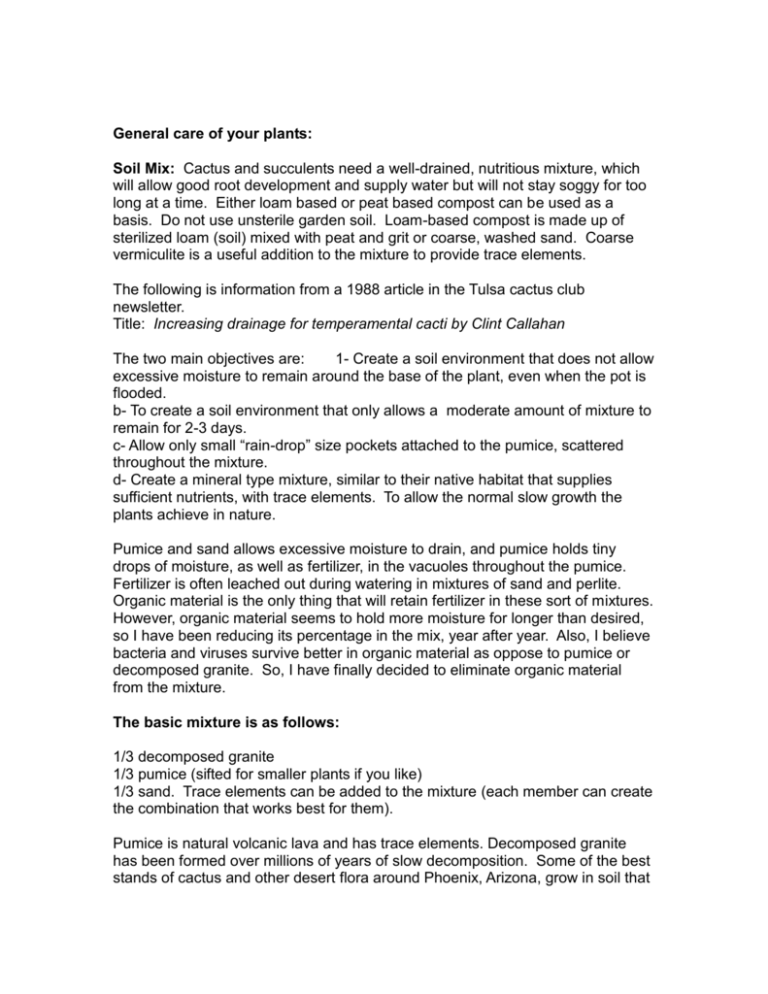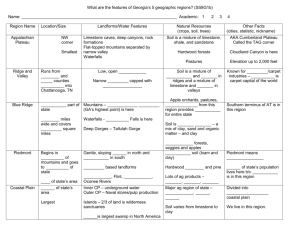General care of your plants - The Cactus and Succulent Plant Mall
advertisement

General care of your plants: Soil Mix: Cactus and succulents need a well-drained, nutritious mixture, which will allow good root development and supply water but will not stay soggy for too long at a time. Either loam based or peat based compost can be used as a basis. Do not use unsterile garden soil. Loam-based compost is made up of sterilized loam (soil) mixed with peat and grit or coarse, washed sand. Coarse vermiculite is a useful addition to the mixture to provide trace elements. The following is information from a 1988 article in the Tulsa cactus club newsletter. Title: Increasing drainage for temperamental cacti by Clint Callahan The two main objectives are: 1- Create a soil environment that does not allow excessive moisture to remain around the base of the plant, even when the pot is flooded. b- To create a soil environment that only allows a moderate amount of mixture to remain for 2-3 days. c- Allow only small “rain-drop” size pockets attached to the pumice, scattered throughout the mixture. d- Create a mineral type mixture, similar to their native habitat that supplies sufficient nutrients, with trace elements. To allow the normal slow growth the plants achieve in nature. Pumice and sand allows excessive moisture to drain, and pumice holds tiny drops of moisture, as well as fertilizer, in the vacuoles throughout the pumice. Fertilizer is often leached out during watering in mixtures of sand and perlite. Organic material is the only thing that will retain fertilizer in these sort of mixtures. However, organic material seems to hold more moisture for longer than desired, so I have been reducing its percentage in the mix, year after year. Also, I believe bacteria and viruses survive better in organic material as oppose to pumice or decomposed granite. So, I have finally decided to eliminate organic material from the mixture. The basic mixture is as follows: 1/3 decomposed granite 1/3 pumice (sifted for smaller plants if you like) 1/3 sand. Trace elements can be added to the mixture (each member can create the combination that works best for them). Pumice is natural volcanic lava and has trace elements. Decomposed granite has been formed over millions of years of slow decomposition. Some of the best stands of cactus and other desert flora around Phoenix, Arizona, grow in soil that is almost 100% decomposed granite. It probably contains the full range of trace elements and in correct proportions. I may put a small amount of bone mea in the bottom one inch of the pot. It must be well mixed in, and not more than 3-5% of the volume of the soils it is mixed with. Gypsum can be added to the mixture for Aztekium ritteri and Strombocactus disciformis. Decomposed granite tends to pack (becomes firm). Sand and pumice help prevent this packing, and makes repotting easier. The more firm you want your soil mix, the more decomposed granite you use. Watering: Water when needed during the growing season; the soil should dry between waterings. When you water, water thoroughly; water should run out of the drainage hole of the pot. Many cacti and succulent have yearly resting periods, during which time they should be kept dryer and cooler than during the growing period. For most cacti the resting period is in late fall and winter, and for most species you can withhold water completely. You have to learn the resting period for your plants. An advantage of buying labeled plants is that you can look up information about them on the web or in books. The frequency of watering depends on the conditions. Plants in a sunny greenhouse may need water twice a week in August, but plants under fluorescent lights in your living room may easily go 2 weeks between watering. Light: Most cactus and succulents require a good amount of light. They are suitable for the areas with the most sun in a home. Pots: Both clay and plastic are available. Plastic pots are cheaper, easier to clean and lighter than clay, but clay pots provide stability or heavier plants. Plants in plastic pots may not require watering as often as those in clay pots. Many cacti and succulents have fibrous roots, which do not require deep pots, thus using half pots of shallow pots is better for them. Re-potting: Ideally this should be done every other year or once every three years depending on how well the plant is growing. Many Haworthias, Gasterias and Aloe benefit from re-potting every 1-2 years since they produce a lot of roots and build up of organic matter in the soil proves to be toxic to the plant. Many Euphorbia, Tylecodon and Cotyledon benefit from re-potting every 1-2 years as well. Another consideration is potting-up. This is done when the plant is placed in a larger pot and more soil is added. This gives the plant more root room to expand. Both repotting and potting up will be needing depending on how long your plant has been in the same pot. Unhealthy plants with fungus or other problems may benefit from having clean soil. Fertilizers: In general do not use these until you learn which plants need them; a low nitrogen fertilizer at half strength is recommended for these plants. Repotting in fresh soil is usually better for your plants than blasting them with nutrients. Plant Diseases Mealies are scale insects without shields and covered in a waxy shell. They present a serious problem for succulent plant growers. Mealy bugs are common pests in greenhouses and interior landscapes. The damage is caused by mealy bugs feeding on host tissues and injecting toxins or plant pathogens into hot plants coating them with a shiny, sticky film. This coating serves as a medium for the growth of sooty mold fungus. This hurts the plant by reducing its ability to photosynthesize and it also ruins the plant’s appearance. One of the best methods of control of mealy bugs is to purchase plants that are not infested. If your you have a plant that is infested with mealy bugs, take it out of the pot, wash the roots in half alcohol, half water and repot with clean new soil. While there are strong insecticides that will do the job, alcohol and water are safer. If your plant is already infested you can spray it with rubbing alcohol. You can mix 1-2 cups of alcohol (use only 70% isopropyl (rubbing) alcohol per quart of water. Another option is using a biological control. One used most often is the mealy bug destroyer, Cryptolaemus montrouzieri. The larvae of this ladybird beetle is a very effective predator, especially when there are many mealy bugs. Adults also feed on mealy bugs.






